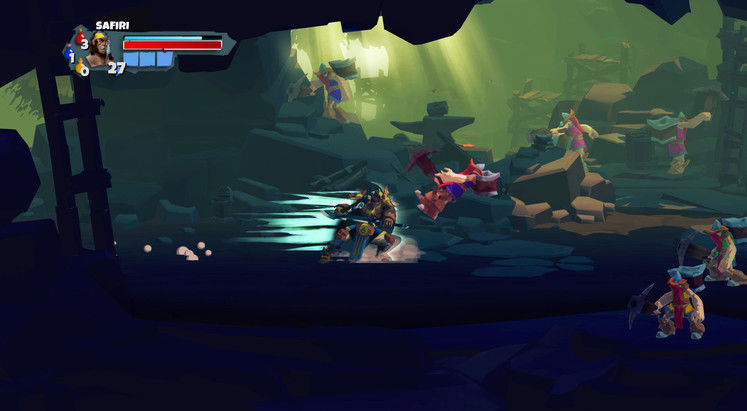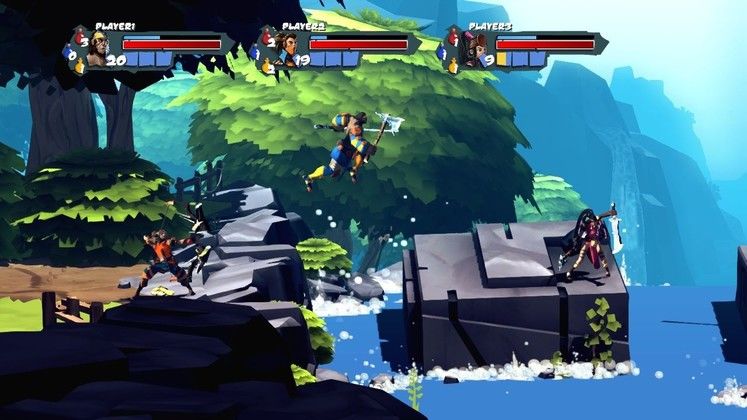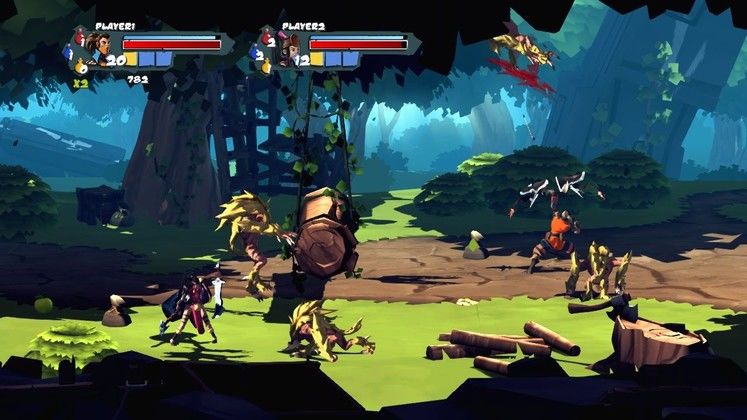The foundations are firmly rooted in traditional side-on brawlers - right down to the insistent in-game soundtrack, which wouldn’t have been out of place blurting out from a Sega system 20 years ago. Up to three people can play co-operatively both off and online, choosing from a selection of four character types and then hacking, slashing and biffing their way left to right through twenty plus stages set across five acts, only stopping for the occasional minimal cut-scene along the way. At the end of each stage your score is totted up and you’re awarded a medal based on your performance. There’s also online leaderboards and achievements for comparison of slaughtering prowess.
 |
| A somewhat brutal approach to ending the local miners’ strike |
The core combat system is arguably the game’s strongest point. The usual layout of jump, light and heavy attacks are on hand, and dealing damage builds up a gauge that allows you to unleash a power attack. Where Sacred Citadel does well is in placing an emphasis on movement and crowd control, avoiding the somewhat plodding pace that can mar some brawlers. Time a left trigger block - and you’ll want to use a controller for the game even on PC, as the keyboard controls are enough to induce RSI just by looking at the layout - and enemies are knocked back allowing you to launch a counter-attack or use the right analog stick to dodge roll out of danger.
Combine this with a combo system tailored to each character’s attributes, and during the early levels, Sacred Citadel’s combat is fast, flowing and generally engaging. The enemies you encounter pack varied if familiar methods of attack, from charging melee brutes to ranged acid-spitting aerial units, and boss battles are sprinkled throughout each stage. Your opponents may be nothing original from a visual design standpoint, but like the player characters themselves they’re fluidly animated with distinctive profiles, allowing you to watch for attack tells and place each unit’s location on the screen’s plane.
It’s all rendered in a painterly water-colour palette that’s attractive without being overly fussy or distracting, although stage design rarely makes enough use of testing traversal or environmental hazards to complicate matters. It’s odd then that the PC version tested should completely omit support for resolutions above 1600 x 900 without messing around with the config file - quite how that one passed Q&A is anyone’s guess, but the result is that the game’s visual style will be compromised for most on that platform.
Bolted on to this foundation, though, is a tottering superstructure of action RPG mechanics that, while providing an illusion of depth and longevity, ultimately prove Sacred Citadel’s undoing. The four available character classes are those ARPG staples the Warrior, Ranger, Mage and Shaman (it’s a shame that some of the more original classes present in Sacred 1 and 2 couldn’t have been included to strengthen the bond with the main series), each with their own skill set and variations of attacks. XP is earned throughout the game, and is persistent for each class, although you can reset at any time.
 |
| One giant leap for the Warrior, one double-jump for everyone else |
As you level up, access to new combos and alternate attacks unlock, as does the ability to use certain items, while you also gain two points per level to expend on your four attributes: Attack, Defense, Dexterity and Power. Your Hit Points and Critical Hit chances improve with both expenditure on attributes and outfitting the right gear.
The ARPG trappings don’t end there, though. Sacred Citadel doesn’t neglect the major draw of the genre: the loot. Weapons can be equipped in left and right hands with some producing secondary elemental effects, while magic staffs, totems and armour can all be outfitted. Enemy item drops are plentiful throughout the levels, with a pop-up overlay providing a comparison with your present equipment stats, and there’s even a hub town in each act where you can stock up or trade in items. Health, Power and Rage potions are mapped to the d-pad for easy access, while Crystals can be expended to provide longer term attribute boosts.
The problem is that not only is the loot little more than a series of stat and visual upgrades - no +28 Swords of Über-awesomeness here - but they fatally unbalance the core gameplay. Brawlers are intrinsically about player skill progression, mastering the mechanics and honing combo control so as to counter the ramped up ferocity and enemy numbers of each subsequent level, all while keeping a keen eye on boss attack patterns. Sacred Citadel’s ARPG elements instead mean that the game simply becomes a matter of bolting on more gear, with the result that both difficulty and the demands on the player actually decline as the game progresses.
For example, by mid-way in the third act, my Level 24 Mage, thanks to some judicious min-maxing of the Power stat and some rather generous random item drops, was able to absolutely marmelise anything that came her way with nothing but the most basic finisher combos. I was even able to beat an end-of-level boss by simply standing still and spamming Magic Blast. In some games, there’s a joy to being ludicrously over-powered, but Sacred Citadel’s highly traditional level design and enemies aren’t satisfying enough victims to make rampaging through them like a force of nature much fun.
 |
| All the local wildlife wanted to do was play on their swingset, but then the slaughter started |
This in turn means that one of the game’s supposed strong points - the persistent leveling and ability to return to any stage at any time with your current stats - also falls flat. The older stages no longer present a challenge to your now upgraded character, and when you do find a level that tests your mettle it’s all to easy to simply go back to another and do that most RPG of activities: grind until you have enough XP or gold to over-power yourself some more.
Sacred Citadel, then, is certainly of interest from a game design standpoint, but more as a warning that sometimes what sounds like a good idea actually isn’t. RPG elements have become more and more common in other genres of video games, but in this example of the side-scrolling brawler, they just don’t work.
Platform Played: PC
SACRED CITADEL VERDICT
Sacred Citadel, then, is certainly of interest from a game design standpoint, but more as a warning that sometimes what sounds like a good idea actually isn’t. RPG elements have become more and more common in other genres of video games, but in this example of the side-scrolling brawler, they just don’t work.
TOP GAME MOMENT
The early levels when you actually have to use the available combos with some degree of skill.




